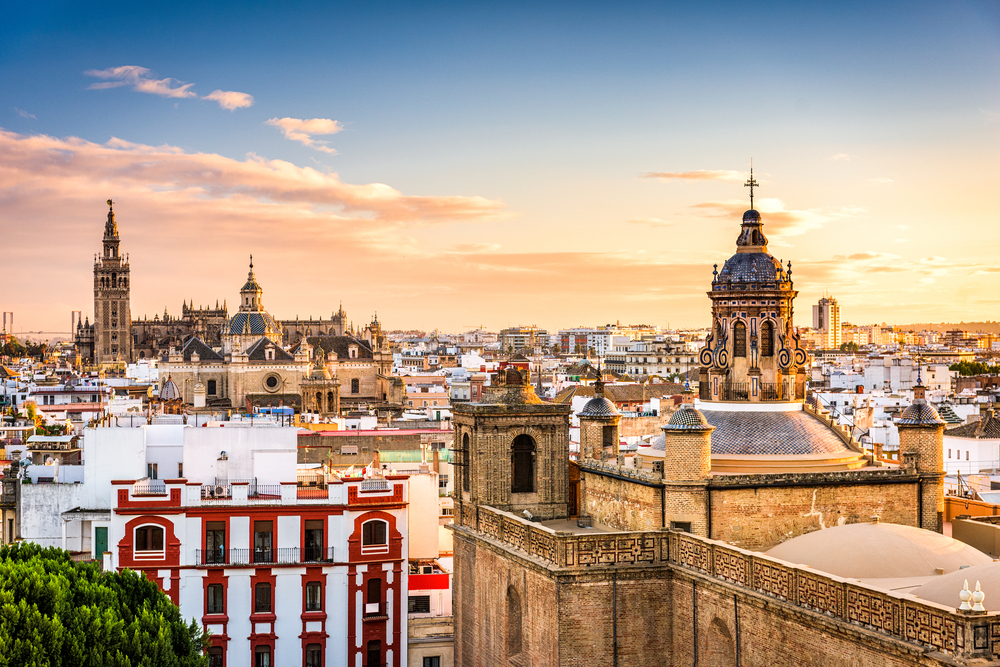Seville and Andalusia, Spain: Insider’s Guide
 Skyline in the Old Quarter of Seville, Spain. Photo: Shutterstock
Skyline in the Old Quarter of Seville, Spain. Photo: Shutterstock
In some cases, Wendy has several trip-planning specialists she recommends for a destination and would like to connect with you directly to determine who would best meet your needs. This is one of those cases. Please click on the CONTACT button (below) to find out from Wendy which travel expert is best for your specific trip goals and challenges.


Plaza de Espana, Seville, Spain. Photo courtesy Casa 1800.
Where to Stay and Eat
Best bang-for-your-buck hotel
Casa 1800 is a well-located four-star in Seville. The rooms on the roof overlook the city, and in one, you can lie in bed and actually see the Giralda tower.
Restaurant worth the splurge
One of the finest restaurants in Andalusia is the two-Michelin-star Dani Garcia in Marbella—and although staying in Marbella is not ideal, many travelers want to go for a day or combine it with a visit to the Picasso Museum in Malaga. Garcia is known for creative, fresh cooking rooted in Andalusian tradition; as the owner of Tragabuches, he helped put the city of Ronda on the map when he became the youngest chef in Spain to receive a Michelin star—he was 24 at the time.
Restaurant the locals love
Los Cuevas in Seville is known for fresh ingredients, reasonable prices, and a menu you can count on: typical Spanish food cooked the same way for generations. Try the sautéed artichokes with Iberian ham followed by scrambled eggs with mushrooms and shrimp.
Must-have dish
The little pastry known as pionono is made by hand in the small town of Santa Fe outside Granada. You can buy it fresh in the city every morning. Best place: Pasteleria Ysla Triunfo.
Prime picnic spot
Parque Maria Luisa is a favorite for picnicking or strolling, and is especially beautiful in the springtime. It is close to the historic core but just far enough away that it is not filled with tourists. The park contains some fantastic monuments from the World’s Fair of 1929 and is a must for anyone who loves architecture or gardens.
What to See and Do
Don’t miss
The White Villages occupy a rocky region of limestone hills that was once the border between Catholic and Moorish Spain; many of the whitewashed towns and villages began as fortresses. Today, their cobblestoned streets and quiet plazas offer a respite from the 21st century. Among the more widely known towns are Arcos, Jerez (famous for its sherry and dressage), and Ronda. Don’t skip the lesser-known Vejer de la Frontera, Grazalema (at the edge of a national park), sleepy Medina Sedonia, Zahara de la Sierra, and Olvera.
Although everyone knows the name, Córdoba is often underrated. Many travelers do it as a day-trip from Seville, since it is only 40 minutes by high-speed train. Unfortunately, they arrive to find the place packed—by other day-trippers, naturally. Spending the night makes all the difference, because you get the town to yourself in the morning and evenings. Two excellent choices for an overnight stay are Balcon de Córdoba and the five-star Palacio del Bailio, a boutique hotel in a sixteenth-century palace in the heart of the ancient city.
Don’t bother
Resist the urge to head to Gibraltar simply to check it off your bucket list. Crossing the border into the disputed territory can take much longer than anticipated, and it’s frequently overrun with cruise-ship tourists.
Travelers who go to the resort town of Marbella expecting jet-set chic are disappointed to find an overpriced mass-market destination: The coast is lined with large resorts and the narrow beaches are overcrowded.
Hidden gem
The Roman city of Baelo Claudia was an important trading post under the emperor Claudius; its well-preserved ruins date back to the second century B.C. Most people miss it—a big mistake. The site is at Bolonia, on the Atlantic coast, in a spectacular location right on the beach. About 20 miles away is the sculpture park of the NMAC Foundation, which invites international artists to create site-specific commissions set in a natural landscape. You can combine both places with a stroll around Vejer de la Frontera on a day-trip from Seville.
Cheap thrills
In Seville, take a cab across the bridge to the barrio of Triana, also known as the Gypsy Quarter, for a late-night drink at a local flamenco bar. There are plenty of bars to choose from—try Tablao Lola de los Reyes. Most require no entrance fee, and odds are high you will be hanging with locals from Seville, especially on a weekend. Best to take a taxi both ways.
In Granada, take a two-hour bus ride to one of the most beautiful towns in Spain: Ubeda is a UNESCO World Heritage Site, famous for its Renaissance architecture—you won’t regret the time it takes to get there.
Downtime
Spend the day at El Puerto de Santa Maria, not far from Jerez but much less touristy. The town is famous for the quality of its sherry and has excellent seafood and tapas bars. In the unlikely case you get bored, Cádiz is a stone’s throw away.
Best Times to Go
Early March through May, when southern Spain erupts in springtime celebration. Seville during Semana Santa—Holy Week—can be hectic, but it is an amazing thing to see the festivities with your own eyes. Consider spending part of Semana Santa in a village and then a small city before ending the week in Seville. If you visit Seville during Feria, the April fair, ask about getting into a private casita belonging to a respected family (not a corporation)—a huge deal. Another good time to visit is fall, which has equally pleasant weather but fewer visitors.
Worst Time to Go
July can be very hot, and August is both hot and sleepy, as some restaurant owners and shopkeepers lock their doors and go on holiday.
Biggest Rookie Mistake
Not getting tickets for the Alhambra in advance. Most people assume you can just walk up and get a ticket; those days passed 20 years ago.
Scam Alert
If somebody offers you a sprig of rosemary in the street, don’t take it. Before you know what is happening, the person—typically, an older woman—will have read your palm and asked for money. Once you accept the twig it is difficult to free yourself; the fortuneteller will not let go until you pay her for her unsolicited service.
Not exactly a scam, but certainly a very bad decision: Don’t book a day-trip to Morocco. Morocco is one of the most amazing places on the planet. Tangier (where you will land) is not. You will be hassled, jostled, harassed in carpet stores. It is crowded with people fresh off cruise ships and more than any city’s fair share of pickpockets. If you do Morocco, give it a minimum of three days and hightail it straight to Fez or Chefchaouen or Asilah.
Must-Have App
Sevilla Map and Walks is nicely designed and very user friendly, with brief descriptions that are well translated and easy to understand. The $4.99 app gives you turn-by-turn navigation. There is also a free version.
Tipping Tip
Most Spanish people don’t tip very much. They will round up for a taxi driver or leave a bit (10% max) at a fancier restaurant. Having said that, most travelers do tip, and waiters and bellhops have come to expect it.
Airport Intel
Allow a bit of extra time at the airport. Spain is Spain, and it cannot be rushed; that is one of its great joys.
While the airport in Malaga is large and has all the modern amenities we’ve come to expect, don’t anticipate the same in Granada or Seville; the choices for snacks and duty-free shopping in those airports are very limited.
Don’t Forget to Pack
Comfortable city shoes that have a good grip—you’ll need them for walking on sloping cobblestoned streets and sidewalks. You won’t spend much time in a car; Spain is all about immersion, and its cities and towns beg to be explored on foot. You don’t want sore feet by the end of the first day.
The Souvenirs
Extra-virgin olive oil, ideally cold-pressed. There’s a saying that some of the best “Italian” olive oil comes from Spain, so why not buy it here? Oro Baena (produced in Andalusia, on a finca not far from Córdoba) is an excellent brand. Look for it in the gourmet section at one of the El Corte Inglés department stores found all over Spain.
Another option: Buy a colorful fan—and learn how to use it. Different gestures carry different connotations, especially in the world of flirting. A fan is beautiful, practical, easy to pack—and a good icebreaker.
Instagram Moment
A sunset photograph of the Alhambra taken from the Albayzin—the Moorish quarter on the opposite hill—or the grounds of the parador. The latter, a convent turned hotel, is part of the Alhambra complex and you can enter whether or not you are a hotel guest.
If the day is clear, it is pretty cool to take a photo of Africa (Tangier, specifically) from one of the high points in Vejer. One good place is the rooftop terrace of the Hotel V.








